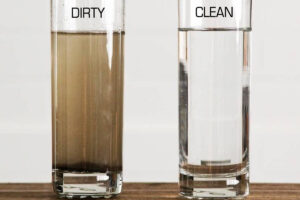“Don’t throw out the dirty water until you have the clean water” was my paternal grandfather’s favorite expression. As an immigrant from Poland, he may have picked it up as a proverb from the old country. Clearly, it is a truism, drawing on images that are universal to humanity, so it could have been invented and reinvented anywhere.
Yet perhaps my grandfather picked it up in America. The Oxford Dictionary of Proverbs (5th edition) lists various English-language versions of the proverb, the most forceful being the earliest (dated 1475): “He is a fool that casts away his old water before he has the new.” (I’ve modernized spelling and grammar.) Even a Latin version exists: “Nolite eicere aquam immundam donec aquam mundam habes.” (Actually, I just made up this Latin version. Perhaps it will catch on.)
Dirty water is never ideal. But few things in life are. If you’re in danger of dying from thirst in a desert and all you have is dirty water, you’ll treat it as a precious commodity. If it comes down to it, you may need to drink it, and it might just save your life. If, because it looks ugly or tastes foul, you decided to toss it, then you’re at the mercy of whatever forces may exist to replace it. Perhaps better comes along to replace it. Perhaps what comes along is no better or even worse than what you tossed out. In any case, tossing the dirty water may incentivize you to look for clean water, but it will hardly guarantee that you’ll find it.
Ours is an age that flouts this proverb. It’s not just that our age routinely tosses out dirty water before getting clean water. Our age also insists on procuring clean water that may not even exist. When it comes to actual water, we all know that dirty and clean water do in fact exist. But when it comes to dirty and clean water used metaphorically, as in this proverb, we have no assurance that clean water even exists.
Consider a recent ruling by the state of California to eliminate the production of gas-powered vehicles and go all in with electric-powered vehicles by 2035. From the vantage our proverb, gas-powered vehicles are the dirty water, electric-powered vehicles the clean water. Whether that’s the right way to identify what’s dirty and clean here could itself be debated. The high cost of electric-powered vehicles, the mining of toxic substances that they require, the challenges that their recycling raises, and the requirement, at least for now, to charge these vehicles by means of electricity generated from carbon-emitting power plants all raise questions about whether in this case a compelling dirty-versus-clean water distinction exists.
But for the sake of argument let’s say that, on balance, electric-powered vehicles are environmentally more friendly than gas-powered vehicles and are therefore to be preferred over them. Even in that case, California’s ruling is not like someone who has a gas-powered vehicle and then prudently waits till an opportune time arises to trade it in for an electric-powered vehicle. The California ruling may be many things, but it is not prudent.
There is no guarantee that, by 2035, it will be technologically sound to rule out production of all new gas-powered vehicles and insist that henceforth all new vehicles produced are electric powered. Making laws that insist on an outcome whose technological feasibility is in doubt may be viewed by politicians as a goad to technological creativity and innovation. Make it impossible to do wrong, and right will prevail. When has that ever worked? Instead of fostering new and better technologies, outlawing existing and workable technologies can easily become an act of self-sabotage and even suicide if the new and better never materialize.
The psychology of suicide is worth a brief digression here. Suicide is often a response to depression, but depression, as the word suggests, depresses our ability to act, and thus can also keep us from following through on suicidal ideation. That’s why anti-depressants like Prozac list suicide as a possible side-effect in that they can lift enough of the depression to spur action, in this case the act of suicide. Often those who attempt to commit suicide are relieved if they don’t succeed. They hoped that a moment of resolve would put them on an irrevocable course to oblivion, but then are relieved that it wasn’t actually irrevocable.
Similar suicidal impulses seem at play when policymakers insist on the complete riddance of dirty water so that only clean water can remain. There’s the desire to chart an irrevocable course. There’s the desire to be rid of half-measures. There’s the desire to commit oneself to a new order of things, a world in which there’s only clean water. And what more effective way to accomplish this than simply to outlaw dirty water? It’s the flip side of “build it and they will come.” Instead, “outlaw it and the alternative will magically materialize.”
But perhaps sabotage more than suicide accurately describes policymakers who insist on ridding the world of dirty water to promote clean water. Policymakers who decry the world’s dirty water typically have no real alternative to dirty water. They might suggest that if they had a button that they could press and eliminate all the world’s dirty water, they would do so and the world would be a better place.
But imagine a world in which all petrochemicals (the bane behind carbon emissions and climate change) suddenly disappeared from all human use. All technology as we know it would cease. Even things not containing petrochemicals, such as things consisting entirely of metal or glass, would disappear because the manufacturing process for these, and everything humans produce, depends on petrochemicals. Derived from petroleum and natural gas, petrochemicals form the building blocks for an incredible variety of materials and applications. Here is a partial list:
- Plastics: Used in a wide variety of products, from packaging to consumer products, building materials to biomedical devices. These include:
- Polyethylene: Used in the production of plastic bags, plastic films, geomembranes, containers, and pipes.
- Polypropylene: Used in the production of packaging, labeling, textiles, stationery, and reusable containers.
- Polyvinyl Chloride (PVC): Used in making pipes, window frames, cable insulation, and vinyl records. (It is the world’s third-most popular synthetic plastic polymer.)
- Polystyrene: Used in the production of plastic cutlery, packaging foam, and insulation materials.
- Synthetic rubbers: Used in tires, footwear, and various other rubber products.
- Synthetic fibers: Used in clothing, home furnishings, and industrial uses.
- Detergents: Used in various cleaning products.
- Fertilizers: Used in agriculture to enhance plant growth.
- Solvents: Used in paint thinners, nail polish removers, glues, and other products.
- Adhesives and sealants: Used in construction, packaging, and consumer products.
- Paints and coatings: Used in protective and decorative layers on surfaces.
- Lubricants and greases: Used in automotive and industrial applications.
- Pesticides: Used in agriculture and household products to control pests.
- Pharmaceuticals: Used as raw materials in the production of various drugs. For instance, petrochemicals like phenol, benzene, and cumene are used to make aspirin, penicillin, and drugs used to treat cancer.
- Cosmetics: Used as raw materials in the production of various personal care products.
- Dyes and pigments: Used in textiles, paints, and printing inks.
- Resins: Used in a variety of applications from coatings to adhesives, electronics, and more.
But petrochemicals are not the only dirty water to be outlawed. More abstract and conceptual topics are also subject to the dirty-vs-clean-water distinction. Consider inequality in the justice system. It is disconcerting that in our society incarceration rates differ significantly across racial, ethnic, and financial lines. For instance, according to Vox, citing a Brookings Institution report, “Boys who grew up in families in the bottom tenth of the income distribution are about 20 times more likely to be in prison in their 30s than boys born into families in the top tenth.” This is unfair. It should not be. It ought to be rectified.
Even so, the justice system as traditionally constituted has been unable to redress this inequality. Break the law and suffer the consequences, and too bad if your circumstances predispose you to experiencing those consequences. That’s the traditional view. This may seem harsh, but what is the alternative? Cashless bail? Defund the police? Early release? Redefining what counts as a felony? Selective prosecution to ensure a proper representation of groups? Yet we are asked to treat these latter options as clean water and jettison the traditional view as dirty water. And how is the new supposedly clean water working out? Is it really cleaner than the old dirty water?
The impulse behind getting rid of dirty water before the clean water has been found and proven to be superior to the old dirty water is utopian. It promises perfection and maligns what has worked in the past for clearly being imperfect. But perfection is not to be had in this world. It has become trite to say that the perfect is the enemy of the good. As with many maxims, it is trite because it is true. But those who throw out the dirty water without having the clean water live as though this maxim is false. And ultimately they, or their successors, will pay the cost of being wrong.
To sum up, Boleslav Dembski, my paternal grandfather, offered a watchword of our age. “Don’t throw out the dirty water until you have the clean water” expresses a pragmatic realism that our age needs to prosper. It is a watchword that our society and politicians increasingly flout. This watchword is antithetical to magical thinking, bizarre purity standards, utopianism, useless austerities, hypocritical asceticism, and so on of those who mistake censorship and curtailment for creativity and innovation. Simply ridding the world of dirty water does nothing to bring clean water into existence. First find the clean water. The dirty water will then take care of itself.

